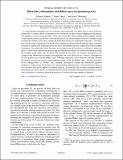| dc.contributor.author | Nomura, Yasunori | |
| dc.contributor.author | Varela, Jaime | |
| dc.contributor.author | Weinberg, Sean J. | |
| dc.date.accessioned | 2013-07-11T18:37:14Z | |
| dc.date.available | 2013-07-11T18:37:14Z | |
| dc.date.issued | 2013-04 | |
| dc.date.submitted | 2012-11 | |
| dc.identifier.issn | 1550-7998 | |
| dc.identifier.issn | 1550-2368 | |
| dc.identifier.uri | http://hdl.handle.net/1721.1/79585 | |
| dc.description.abstract | A coarse-grained description for the formation and evaporation of a black hole is given within the framework of a unitary theory of quantum gravity preserving locality, without dropping the information that manifests as macroscopic properties of the state at late times. The resulting picture depends strongly on the reference frame one chooses to describe the process. In one description based on a reference frame in which the reference point stays outside the black hole horizon for sufficiently long time, a late black hole state becomes a superposition of black holes in different locations and with different spins, even if the back hole is formed from collapsing matter that had a well-defined classical configuration with no angular momentum. The information about the initial state is partly encoded in relative coefficients—especially phases—of the terms representing macroscopically different geometries. In another description in which the reference point enters into the black hole horizon at late times, an S-matrix description in the asymptotically Minkowski spacetime is not applicable, but it still allows for an “S-matrix” description in the full quantum gravitational Hilbert space including singularity states. Relations between different descriptions are given by unitary transformations acting on the full Hilbert space, and they in general involve superpositions of “distant” and “infalling” descriptions. Despite the intrinsically quantum mechanical nature of the black hole state, measurements performed by a classical physical observer are consistent with those implied by general relativity. In particular, the recently-considered firewall phenomenon can occur only for an exponentially fine-tuned (and intrinsically quantum mechanical) initial state, analogous to an entropy decreasing process in a system with large degrees of freedom. | en_US |
| dc.description.sponsorship | United States. Dept. of Energy. Office of High Energy and Nuclear Physics (Contract DEFG02-05ER41360) | en_US |
| dc.description.sponsorship | United States. Dept. of Energy. Office of High Energy and Nuclear Physics (Contract DE-AC02-05CH11231) | en_US |
| dc.description.sponsorship | National Science Foundation (U.S.) (Grants PHY-0855653) | en_US |
| dc.description.sponsorship | National Science Foundation (U.S.) (Grant DGE-1106400) | en_US |
| dc.description.sponsorship | Simons Foundation (Grant 230224) | en_US |
| dc.language.iso | en_US | |
| dc.publisher | American Physical Society | en_US |
| dc.relation.isversionof | http://dx.doi.org/10.1103/PhysRevD.87.084050 | en_US |
| dc.rights | Article is made available in accordance with the publisher's policy and may be subject to US copyright law. Please refer to the publisher's site for terms of use. | en_US |
| dc.source | APS | en_US |
| dc.title | Black holes, information, and Hilbert space for quantum gravity | en_US |
| dc.type | Article | en_US |
| dc.identifier.citation | Nomura, Yasunori, Jaime Varela, and Sean J. Weinberg. Black Holes, Information, and Hilbert Space for Quantum Gravity. Physical Review D 87, no. 8 (April 2013). © 2013 American Physical Society | en_US |
| dc.contributor.department | Massachusetts Institute of Technology. Center for Theoretical Physics | en_US |
| dc.contributor.department | Massachusetts Institute of Technology. Department of Physics | en_US |
| dc.contributor.mitauthor | Nomura, Yasunori | en_US |
| dc.contributor.mitauthor | Varela, Jaime | en_US |
| dc.relation.journal | Physical Review D | en_US |
| dc.eprint.version | Final published version | en_US |
| dc.type.uri | http://purl.org/eprint/type/JournalArticle | en_US |
| eprint.status | http://purl.org/eprint/status/PeerReviewed | en_US |
| dspace.orderedauthors | Nomura, Yasunori; Varela, Jaime; Weinberg, Sean J. | en_US |
| mit.license | PUBLISHER_POLICY | en_US |
| mit.metadata.status | Complete | |
